Welcome to the first post in our annual “Staff Picks” series, in which the Ani-Gamers team selects some of our favorite anime, manga, and video games of the past year. As is the custom, we begin with manga.
2019 was a year of transition for the manga industry. The breadth of manga available in North America is larger than ever thanks to an array of seemingly thriving publishers. Japan-backed veterans Viz Media and Kodansha Comics continue to pump out great books, Seven Seas is more active than ever, and Square Enix has now thrown their hat into the ring with a new US-based subsidiary. But the biggest news of the year is the rise of digital manga services. In late 2018 Viz launched their revamped digital Shonen Jump experience (simulpubs and the full back catalog for some of the most popular manga in the world for the absurdly low price of $1.99 a month), followed shortly thereafter by Shueisha’s Manga Plus, a competing free manga service offering major titles from Viz’s Japanese parent company (go figure). Meanwhile, third-party services like MangaMo are starting to explore the digital subscription space. 2020 may just be the year that manga has its Crunchyroll moment.
That’s all the business side, though! Now it’s time to talk about the comics themselves. This year we’ve got three staff members participating, showcasing stellar manga stories across the genre spectrum, from whimsical fantasy to gothic horror to understated romance. Enjoy, and feel free to chime in with your own 2019 picks in the comments.
David Estrella
#3: At the Mountains of Madness
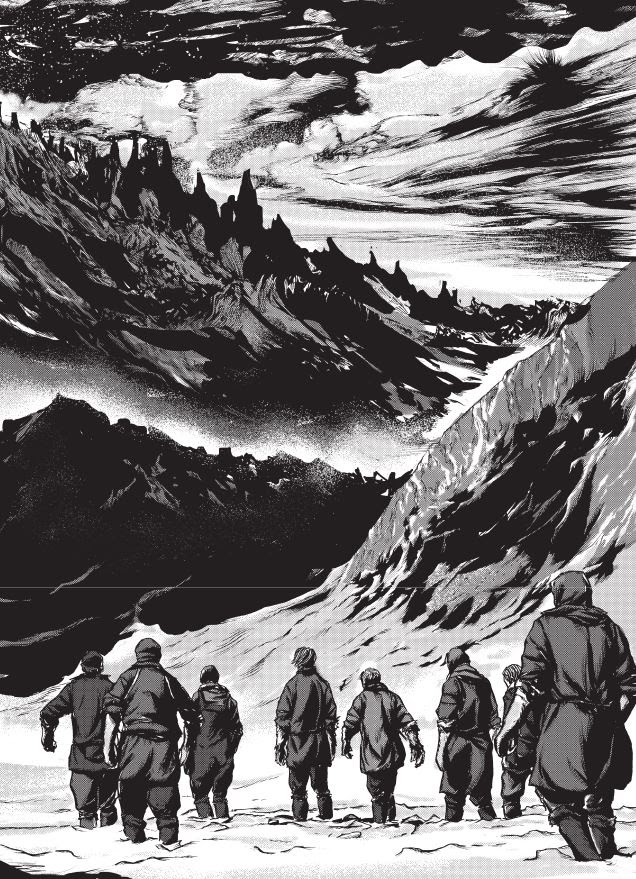
Quick disclaimer: H.P. Lovecraft was a big-time racist and I’m very aware of the contemporary re-evaluation of his works in the context of the man’s politics. That said, Gou Tanabe’s adaptation of Lovecraft’s novella is still an incredible work that should be taken with the illustrator’s own merits in mind. It’s Tanabe’s own talents that really elevate an old story that has been mined for parts and made relatively obsolete by other creators. As an artist, Tanabe’s visuals paint a perfect picture of alien desolation and dread, and his approach to pacing has few parallels among his peers. It’s a manga that doesn’t read like a typical manga and as far as graphic novels go, Tanabe is comfortable pulling from as many Western influences as needed without losing sight of his own identity and ideas. It’s simply a good comic from an artist that’s probably better than Lovecraft deserves.
#2: Bakemonogatari
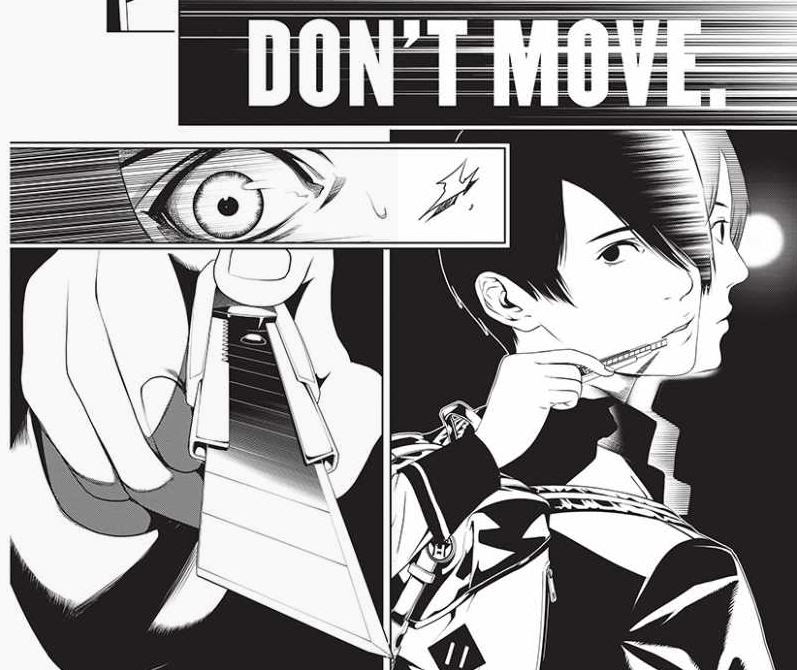
Having rewatched the TV series innumerable times before reading the novel, I was convinced there wasn’t much new ground to break with Bakemonogatari. Oh!Great proved me wrong. The manga artist’s career-defining works had their moment before I was aware of them so I came into this unprepared for what I would find. Not content to simply rely on Nisioisin’s prose to carry the familiar story of a boy, a girl, and the crab spirit that stole her physical weight, Oh!Great pushes the imagery to extremes that not many artists would dare attempt. It’s almost overwhelming to see the ambition in every page that features some wild shifts in angles and perspective and yet remains totally comprehensible. The kinetic energy of the manga does override some of the finer, subtler points of the source but I can respect it as its own creation separate from the original.
#1: Nicola Traveling Around the Demon’s World

Nicola Traveling Around The Demon’s World is the best manga that I’ve read in 2019, rising above even my Monogatari bias on the virtue of being a completely new and fresh title, drawn with an infectious sense of joy and wonder that you can’t find in much of anything these days. I tend to fly through manga as quickly as I can read it, to the dismay of any hard-working comic artists reading this, but Nicola is worth the time to slow down and properly take in all the details inked onto the pages. It’s not Asaya Miyanaga’s desire to show off their skills when the panels are brimming with character, but instead it’s their love for their creation. Nicola might have run in a magazine explicitly marketed at adult readers but it would be unfair to place it in a box that would discourage young manga fans from reading this.
Ink
#3: Kino’s Journey – The Beautiful World
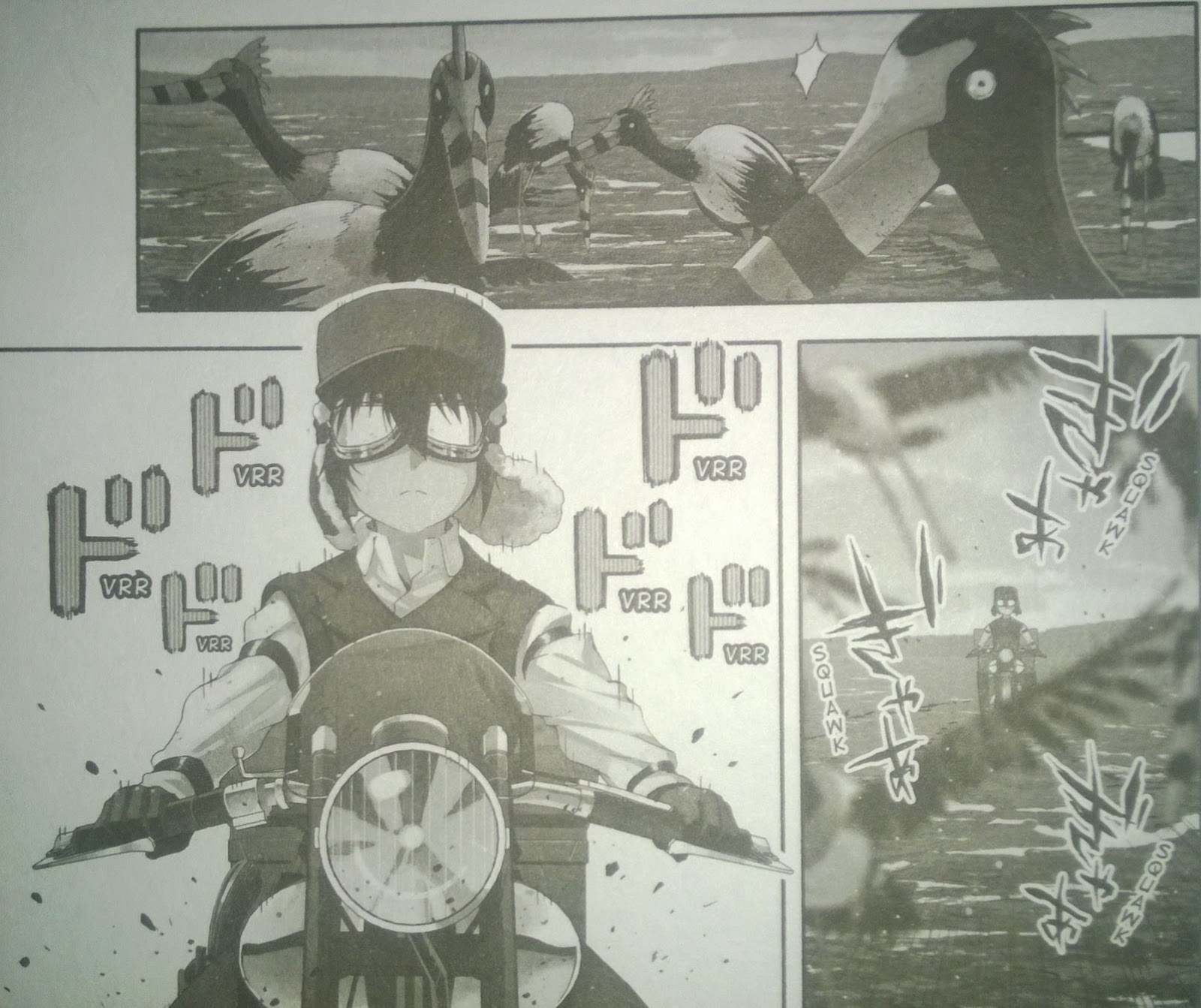
As someone who remains 100% in love with the 2003 anime adaptation of some of Keiichi Sigsawa’s Kino’s Journey novels and someone who found the 2017 anime adaption reboot largely soulless and hugely disappointing, I am fully prepared to defend my claim that this manga not only carries the very essence of the 2003 adaption but successfully builds on it in a few ways. First off, the stories, which include new and established chapters, are by Keiichi Sigsawa, so everything’s right from the source (via translator) there. Secondly, illustration by way of Iruka Shiomiya offers everything one could ask for in a title with such disparate situations as Kino’s Journey. Gone is the bishi Kino of 2017, and the more androgynous design returns. Heavy detail is placed into Kino’s motorad, Hermes, as well as weaponry and other machinery, but more detail is also placed on gore … which is a lot more prevalent and, as one might expect, not illustrated in detail to evoke a feeling of pleasure. Each volume also begins with a lovingly drawn, two-page spread overlain with a translation from Sigsawa’s original novels. This manga is only #3 on my list, because it’s another, albeit fantastic, iteration of something I already love, and that puts it at an unfair advantage over the other two in my list.
#2: Girls’ Last Tour
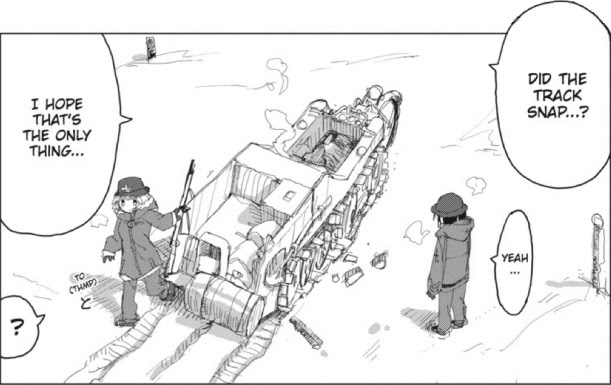
When the anime adaptation of Tsukumizu’s Girls’ Last Tour manga aired, the series of successive vignettes seemed the spiritual successor to the 2003 adaptation of Kino’s Journey. The episodes, like the source material, focus on moe blobs Chito and Yuuri exploring a stratified, post apocalyptic landscape via kettenkrad in search of, well, anything. While the episodes sometimes feel like a platformer video game with regard to how characters get from point A to point B, the human elements of observation and imagination are ultimately what make the series so enthralling in portraying the means necessary for maintaining sanity in the face of desolation. The anime, however, does not adapt all of the manga; the last two volumes are (as of yet) not adapted, and they are worth reading to the very end. The manga sports a style that melds the industrial with the abstract/absurd to simultaneously isolate humanity and show the ways in which it thrives. The chapters are often pensive think pieces which exploit innocence as a lens to both denounce the destruction of an inherited world and praise that which is found therein. The art, despite being hyper-mechanically and -pasturally focused, is admirably minimalist; a few lines often define landscapes, and the resulting emptiness is of the utmost importance for atmosphere and tone. Panel progression and related mastery of visual metaphor are so very important to the interpretation that I question whether dialog is necessary at all. That said, the charming, often (but not constantly) comical relationship between the odd couple MCs does help move moments along in the more stagnant bits while providing enough chuckles to press on.
#1: Happiness
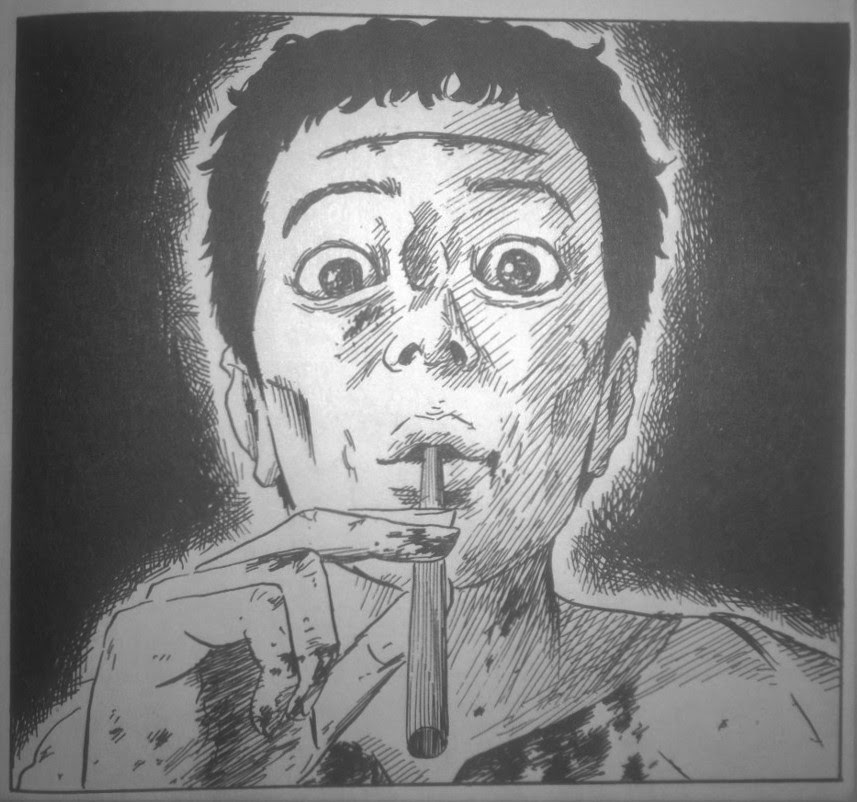
Despite being a huge fan of Shuzo “Your Mental Discomfort is My Middle Name” Oshimi, this manga is about vampires, and I am very much burnt out on vampires and werewolves and zombies and the like. To be fair, however, Happiness is just as much about vampires as most vampire movies are about vampires. That is to say they are about (a) hunger. More to the point, and more to Oshimi’s forte, this 10-volume deep-dive into a youth mentally dealing with his newly awakened, biological need to feed is a visual feast from which Oshimi wants readers to catch the warm coppery waft of life. I fell in love with this title with Volume 2. The initial concept in the visual depiction of hunger – a swirling and distortion of character POV that increases in magnitude with the length of abstinence – feeds right into Oshimi’s Francophilia; post-impressionist landscapes and portraits are definite influences, and other European styles are invoked as well for jaw-dropping art used mainly in chapter breaks. Oshimi’s visual style has improved by leaps and bounds since Flowers of Evil, and that’s saying something given how much I love the visuals in the latter volumes of that title.
Evan Minto
#3: Bloom Into You
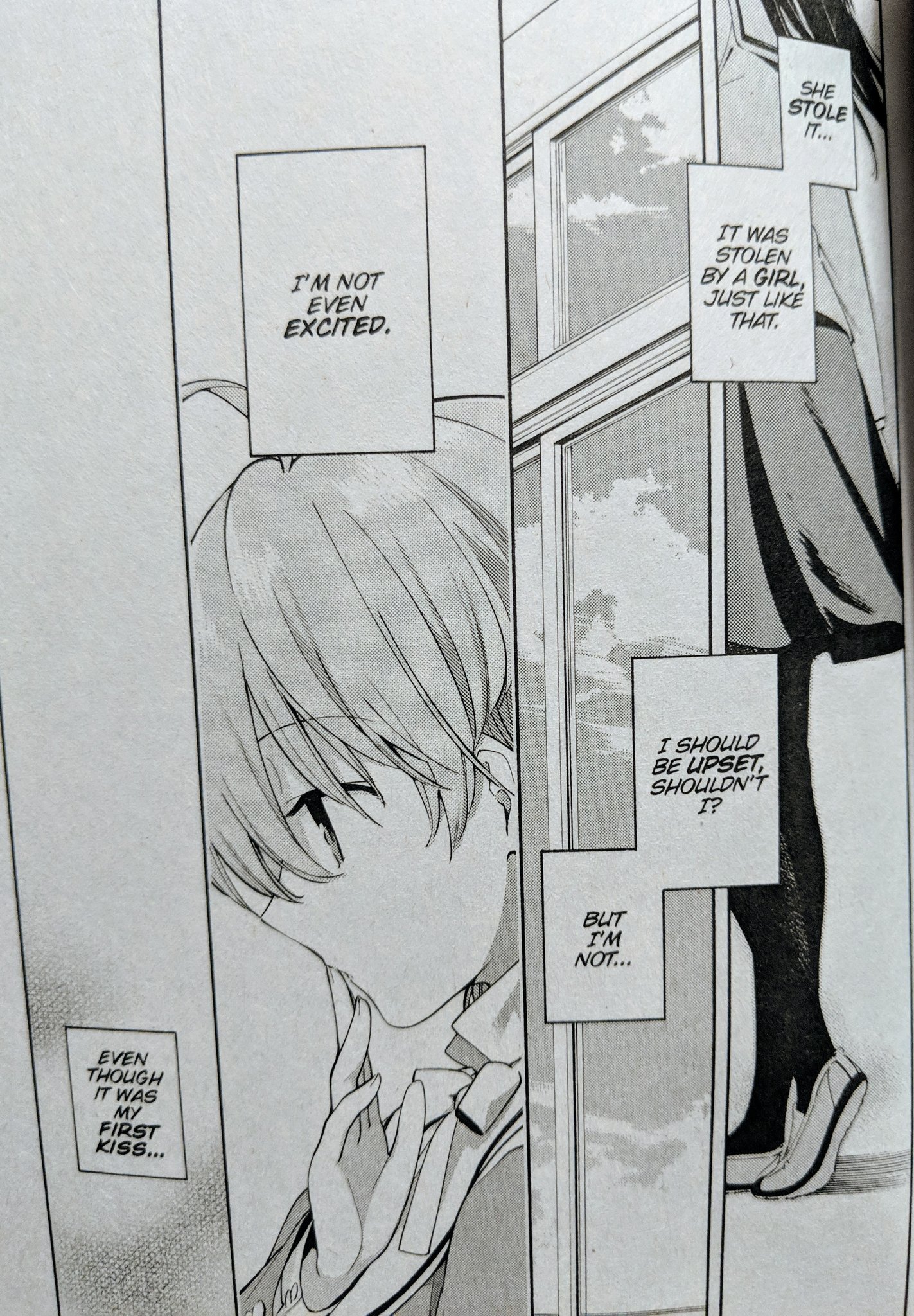
It’s been a pretty quiet year for Bloom Into You, with only a single book (volume 6) released in the US. However, 2019 was the year I discovered this wonderful manga, so here it is on my list. Bloom Into You is a yuri manga with an unlikely premise: its main character, Yuu, has never had feelings for anyone, boy or girl. Even when Touko, the seemingly perfect student council president, confesses to her, Yuu feels nothing, but as she spends more time with her she finds a hint of something growing in her heart. Bloom Into You is all about the slow burn, the uncertainty and furtive glances of young love. But what especially sticks out to me is the way it captures — intentionally or not — the experience of asexuality. Where most manga romances follow characters seeking love from others or obliviously stumbling into it while the audience cheers them on, Bloom Into You is about the process of introspection and overthinking, as Yuu tries to figure out if she is even capable of love. Nio Nakatani’s character designs and realistically stylish costumes are a delight, and come to life beautifully in her flowing, evocative art style. Volume 6 centers on a climactic moment in both Yuu and Touko’s arcs, and I can’t wait to see how this series wraps up next year.
#2: Witch Hat Atelier

It’s rare that I find a manga that I want to read for the artwork alone. Kamome Shirahama’s Witch Hat Atelier is exactly that, and as if the stunning art weren’t enough, the story is also fascinating in its own right. Coco is a village girl who dreams of magic, but rarely gets the chance to interact with the mysterious witches of her country. When a grave mistake causes Coco to unleash a dangerous spell on her village, she gets taken in as a witch’s apprentice and discovers her country’s long-held secret: magical power isn’t innate, but is called forth by drawing magical signs with special ink. Anyone can draw, and thus, anyone can make magic. That direct metaphor for art would be pretty inspiring if Shirahama’s illustration style weren’t so intimidatingly beautiful. Everything from characters to backgrounds is painstakingly rendered in a style that’s halfway between a woodblock print and the textured drawings of Kaoru Mori (A Bride’s Story). The world of Witch Hat Atelier feels tangible, weighty, lived-in, yet simultaneously light and whimsical. I’ve only just started on Coco’s journey, but with art like this I will read just about anything Shirahama puts out.
#1: Chainsaw Man

Viz launched their Shonen Jump app in late 2018, offering easy access to dozens of currently running and retro manga series from Shueisha’s flagship boys magazine. As for me, I jumped into the app and skipped right past One Piece and its ilk to find the most dangerous Shonen Jump manga of all: Chainsaw Man. Denji is a horny 16-year-old boy who makes money by selling off his organs and hunting monsters called “devils.” When he dies (spoilers), his pet chainsaw-dog devil merges with his body, turning him into “Chainsaw Man,” which is basically just “Denji but with chainsaws growing out of his arms and head.” Tatsuki Fujimoto’s manga is an unhinged, action-packed spectacle of blood, guts, and bone-headed idiocy, fueled by the antics of Denji (number one goal: “touch some boobs”) and his unstable devil-hunting partner Power (a devil possessing the body of a dead girl). The series is heavy on the comedy, bouncing a cast of morons and psychopaths off of each other in increasingly destructive ways, but it also takes turns into heavy drama and even romance, all of which Fujimoto handles with a surprising amount of sensitivity. The art is scratchy and high-contrast, but full of unforgettable action set pieces including a giant fox demon taking a bite out of a building and a high-speed car chase with a devil who can turn anything she touches into a bomb. Chainsaw Man is the closest thing we’ve got to reading a Hiroyuki Imaishi (Promare) doujin manga in English, so naturally it’s my manga of the year.
